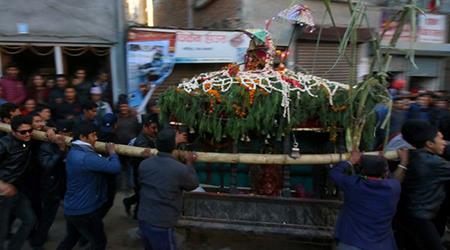Every year according to Nepal Samvat, Gunlathwa Punhi, and Vikram Samvat, the day of Shravan Shukla Purnima is celebrated as Janai Purnima. Different communities of Nepal celebrate this festival in their own way, just like on this day Brahmins and people with strings(janai) change their bodies and wish good luck by tying a rope around their hands. Similarly, it has a special significance in the Newa community of the valley.

This day is known in the Newa community as Gumpunhi or Kwati Punhi. As the 10th month of Nepal Samvat falls on the full moon, it is considered as Gumpunhi. It is customary to eat different dishes at every full moon and festival. In Nepal Bhasa, Kwa means hot and `ti means liquid, hence this full moon is also called Kwati again. This word has been misunderstood and is now called Kuanti by non-Newa. On this day, 9 sprouts of soaked sprouts are mixed and cooked to make soup and wheat bread. For this, it is customary to soak nuts two days in advance, i.e. on the day of Dwadashi. White bean, corn, bakula, bodi, gram, bean meat, bean mung bean, soybean, etc. are mixed with nine types of bean curd. It also contains jwano, coriander seeds, and cumin seeds. According to traditional beliefs, cumin is considered as a symbol of mosquito, coriander is considered as a symbol of nuts, and jwano is considered as a symbol of fly. It is believed that mosquitoes, flies, and aphids will not cause any pain if you look at your face in Kwati on this day.
Similarly, another major aspect of this day is the custom of feeding rice to the frogs. In sal leaves or bean leaves, rice, nuts, meat, and various dishes are first offered in front of the main door. After this, it is also kept on the roof for the birds. Then all the parts are carried to the field and put in different places for the frogs. According to legend, once Indradev was angry, he kept all the zebras and junkiris under control so that he would not water them. Indradev, who had the rule to water the frogs after they cried, kept all the junkiris with him and laughed at how the frogs could cry. Even when it is time to plant paddy, a wise frog came to the farmers who were worried that there would be no change in the rains. Seeing no other way, the farmers agreed. That night, a group of farmers came with small spices and light crops. When I saw the oncoming herd from a distance, all the frogs in the fields started screaming. Surprised to hear the frogs roaring, Indradev finally had to water as per the rules and all the farmers were happy after the heavy rain. It is believed that the frogs were fed with respect as they were happy to help the crops grow by watering them on time. According to another legend, the demon is believed to have been killed for the pleasure of helping to kill it. Generally speaking, the frogs in the paddy fields work to protect the small insects from eating grasshoppers. This practice of feeding food to even small creatures like frogs is a unique example of nature worship.
On this day, Shri Sarveshwar Mahadev, who is in the Banglamukhi premises of Patan, is taken out of the main temple and placed in the nearby Silu pond. If a fair is held in the area during this day, it is known as Quanti Mela. Similarly, on this day, the Rajopadhyayas and Tagadharis within the Newa community change their strings(janai). In the Newa community, although there is no practice of wearing janai in most of the communities within the community, it still exists in some communities. In the Newa: community, especially Rajopadhyay and Karmacharya priests tie the knot these days. Thus Newa: Gumpunhi is celebrated in the community in its own way.
The full meaning of pasuka is panchasuka in Nepali, meaning 5 different colored threads. There are 5 colors of yarn in red, yellow, black, green and white.








0 Comments